简单句并列句和复合句
简单句、并列句和复合句
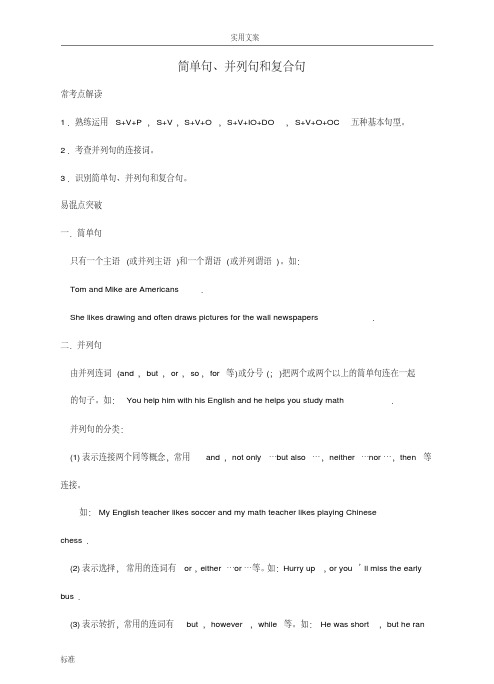
简单句、并列句和复合句常考点解读1.熟练运用S+V+P,S+V,S+V+O,S+V+IO+DO,S+V+O+OC五种基本句型。
2.考查并列句的连接词。
3.识别简单句、并列句和复合句。
易混点突破一.简单句只有一个主语(或并列主语)和一个谓语(或并列谓语)。
如:Tom and Mike are Americans.She likes drawing and often draws pictures for the wall newspapers.二.并列句由并列连词(and,but,or,so,for等)或分号(;)把两个或两个以上的简单句连在一起的句子。
如:You help him with his English and he helps you study math.并列句的分类:(1)表示连接两个同等概念,常用and,not only…but also…,neither…nor…,then等连接。
如:My English teacher likes soccer and my math teacher likes playing Chinesechess.(2)表示选择,常用的连词有or,either…or…等。
如:Hurry up,or you’ll miss the early bus.(3)表示转折,常用的连词有but,however,while等。
如:He was short,but he ranvery fast.(4)表示因果关系,常用的连词有so,for等。
如:He felt bad,so he didn’t go to schoolthis morning.三.复合句复合句指的是含有两个或更多的主谓结构的句子,其中有一个(或更多)主谓结构充当句子某一(些)成分,如主语、宾语、表语、定语、状语、同位语等,主语从句、宾语从句、表语从句、同位语从句、定语从句和状语从旬都属于复合句。
简单句,并列句,复合句
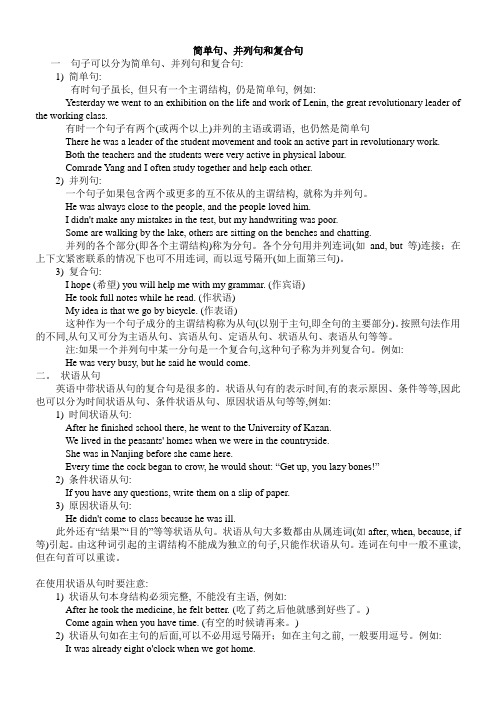
简单句、并列句和复合句一句子可以分为简单句、并列句和复合句:1) 简单句:有时句子虽长, 但只有一个主谓结构, 仍是简单句, 例如:Yesterday we went to an exhibition on the life and work of Lenin, the great revolutionary leader of the working class.有时一个句子有两个(或两个以上)并列的主语或谓语, 也仍然是简单句There he was a leader of the student movement and took an active part in revolutionary work.Both the teachers and the students were very active in physical labour.Comrade Yang and I often study together and help each other.2) 并列句:一个句子如果包含两个或更多的互不依从的主谓结构, 就称为并列句。
He was always close to the people, and the people loved him.I didn't make any mistakes in the test, but my handwriting was poor.Some are walking by the lake, others are sitting on the benches and chatting.并列的各个部分(即各个主谓结构)称为分句。
各个分句用并列连词(如and, but 等)连接;在上下文紧密联系的情况下也可不用连词, 而以逗号隔开(如上面第三句)。
3) 复合句:I hope (希望) you will help me with my grammar. (作宾语)He took full notes while he read. (作状语)My idea is that we go by bicycle. (作表语)这种作为一个句子成分的主谓结构称为从句(以别于主句,即全句的主要部分)。
简单句 并列句 复合句

1. 陈述句(Declarative Sentences)
用来说明一个事实或陈述一种看法。例如: 1) Light travels faster than sound.
光比声传播速度快。(说明事实) 2) The film is rather boring.
这部电影很乏味。(说明看法)
要特别注意陈述句的否定结构
6. 状语 ( Adverbial )
常指修饰动词、形容词或副词的成分,修饰动词时 表示动作发生的时间、地点、目的或方式等;修饰 形容词或副词时表示它们的程度等。状语常由副词、 介词短语、动词不定式或分词短语等充当。 例如: 1. The miners work very hard. 2. She often helps Mike at school. 3. Hearing the news, he couldn’t help jumping.
3. 宾语 ( Object )
常指及物动词或介词后面使之意思完整的词或短语。 常由名词、代词、动词不定式或动名词短语等充当。 例如: 1. She has finished doing the experiment. 2. We like English and are good at it.
4. 表语 ( Predicative )
5)主 + 动 + 间宾 + 直宾 例如: My mother made me a new dress. 我母亲给我做了一件新衣裳。
IV. 并列句的常用连词
1. 我们常用并列连词and, not only…but also…等 连接联合并列句,用not only…but also… 时, 前面一句要用部分倒装 。例如: 1)Use your head, and you’ll find a way. 2)Not only does he want to come, but the students also need him.
简单句并列句复合句

能连接并列复合句的副词
• besides 而且,还有 • hence 由此,因此 • nevertherless然而 • moreoever加之,因此 • otherwise 否则,要不然 • then 然后,于是 • therefore 因此,要不然 • then 然后,于是 • therefore因此,所以 • thus 因而,从而 • i am not feeling very well today, otherwise i would do
• 第四种句型: • 主语+动词+间接宾语+直接宾语 • 如:He brings me cookies every day. • They gave him a watch.
• 第五种句型: • 主语+动词+宾语+宾语补足语 • 如:He asked me to answer this question. • We often see him play basketball alone.
• 如:The old woman lives alone, but she never feels lonely.
• we love peace but we are not afraid of war.
第三种:表示选择关系
• 此类并列连词有or, otherwise, either…or…等。
• 第二种句型: • 主语+动词+宾语 • 如:He loves his wife.
• We will always remember the junior high school life.
• 第三种句型: • 主语+连系动词+表语 • 如:I am a winner. • The music sounds nice. • We are in the classmate.
高考复习-简单句-并列句和复合句

像上面这样,用从属连词连接两个简单句之后, 一个句子是主要的(主句),另外一个句子(从 句)是说明主要句子发生的时间、原因、条件等, 这样构成的句子称为复合句。
C.一个句子如果含有从句,如名词性从句(主语从句、
宾语从句、表语从句和同位语从句)、定语从句和状语 从句等,这个句子就是复合句。
定)语从句
I don’t know where he comes from.(
宾)语从句
Where he was born is not known yet.(
主)语从句
This place is where they once lived.(
表语)从句
考点5 一个句子有两个主谓结构时,要 考虑它们之间的连接问题
Dad on the farm.
并列句
考点4 引导的是什么从句,不仅要根据连词,还要根据句 子结构和句意来判别
说出下列复合句中,where引导的是什么从句。
You can find it where you left it.(
状)语从句
Tell me the address where he lives.(
His wife was ill, so/and he had to stay at home.
考点3 复合句
A. 用从属连词连接的句子是复合句。
还先两个错句: He likes English, his English is very good. × His wife was ill, he had to stay at home. ×
5.Both Tom and Jack enjoy country复m合u句sic.
简单句并列句复合句

The Simple, Compound and Complex Sentences简单句、并列句和复合句句子可以分为简单句、并列句和复合句几种形式,分别说明如下:1。
简单句只包含一个主谓结构的句子叫简单句。
如:We have learnt English for 3 years。
我们已经学英语3年了。
Her dream has become a reality.她的梦想成为了现实。
有时一个句子中有两个或两个以上的词担任主语或谓语,这个句子仍是简单句,只是这个简单句的主语或谓语由两个或两个以上的并列的词共同构成。
如:Mary, Mark and Jesse are all from USA。
(三个并列的名词担任主语)玛丽,马克和杰西都来自美国.These electrical appliances, meters and instruments are all good in quality. 这些电气设备,仪表和仪器的质量都很好。
The workers of the shipyard will dismantle the machine, clean its parts and reassemble it。
(三个并列的动词短语担任谓语)船厂的工人将拆卸该机器,清洁其部件,并重新组装.She has won many awards, and has even written a book about her experiences.她赢得了许多奖品并写了一本有关她的经验的书。
2. 并列句包含两个或两个以上的互不依从的主谓结构的句子叫做并列句.如:Our chief engineer ordered some spare parts and the shipchandler will deliver them on board this afternoon.我们轮机长订购了一些备件,今天下午供应商会把它们送到船上来。
简单句及并列句和复合句

一.五种简单句1.主语+不及物动词(主+谓)He laughed.2.主语+及物动词+宾语(主+谓+宾)I like Chinese food.3..主语+及物动词+间接宾语+直接宾语(主+谓+宾1+宾2)She taught them physics.4.主语+及物动词+宾语+宾语补足语(主+谓+宾+宾补)We must keep the room warm.5. 主语+连系动词+表语(主+系+表)The weather is very cold.二.并列句He is a worker and I am a worker, too.He is very happy but his mother is very sad.上述两句地位一样,如同湖北的省长和湖南的省长一样,地位相等,称为并列句。
三.主从复合句If you are free, we will go to Beijing to play.前者地位低,为后面的主句服务,叫从句。
后者地位高,为主句。
两句合二为一,为主从复合句。
问题:主句与从句怎么辨别?四.从句种类很多。
句子成分划分:主语,谓语,宾语,定语,状语,补语,表语,同位语。
(8种)(主语从句,宾语从句,表语从句,同位语从句)-----名词性从句(定语从句)------形容词性从句(状语从句)------副词性从句Whether we will go shopping depends on the weather.( )He said that he wanted to go to town. ( )That is what I wanted. ( )Y ou are the man who I am looking for. ( )I will help you although I am not very rich. ( )The news that Mr.Li will be our new English teacher is true. ( )。
简单句、并列句和复合句的区别

简单句、并列句和复合句的区别在英语中,句子根据句子结构可以分为:简单句、并列句和复合句。
你知道要怎么区别简单句、并列句和复合句吗?接下来,店铺跟你分享简单句、并列句和复合句的区别方法。
如何区分简单句、并列句和复合句简单句、并列句和复合句的区别一、简单句当一个句子只包含一个主谓结构时,我们称之为简单句。
The train(主语) has just touched down(谓语).在英语中,最基本的句型大体上有五种。
1. S+Vi:主语+不及物动词She sat down beside me.2. S+V+P:主语+系动词+表语Mother isn't in at the moment.3. S+Vt+O:主语+及物动词+宾语I hope to finish the work today.4. S+Vt+OI+OD:主语+及物动词+间接宾语+直接宾语My uncle gave me a camera.5. S+Vt+O+C:主语+及物动词+宾语+宾语补足语The news made us sad.备注:S:主语Vi:不及物动词Vt:及物动词O:宾语OD:直接宾语OI:间接宾语C:宾语补足语二、并列句两个或两个以上独立的主谓结构或简单句并列在一起,我们称之为并列句。
各个简单句间是平行并列的关系,而非从属关系。
并列句的各个分句间可用逗号、分号、起连接作用的副词或并列连接词来连接。
1. 能连接并列句的连词and(和,又),but(但是),for(因为),however(然而),or(或者),so(所以,因而),while(然而),yet(然而)2. 能连接并列句的复合连词or else(否则,要不然),either...or...(要么···,要么···;或者···,或者···),neither...nor...(既不···,也不···),not only...but also(不仅···,而且···)3. 能连接并列句的副词besides(而且,还有),hence(因此),otherwise(否则,要不然),then(然后,于是),therefore(因此,所以),thus(因而,从而) 根据并列分句之间的不同关系,并列句则可以分为以下四种。
英语简单句、并列句、复合句

名师手记之:英语篇(简单句、并列句和复合句)1.简单句、并列句和复合句① 句子种类两种分类法按照句子的用途,英语的句子可分:陈述句(肯定、否定)、疑问句(一般、特殊、选择、反意)、祈使句、感叹句等四种。
按照句子的结构可分:简单句并列句和复合句三种。
简单句只有一个主语或并列主语和一个谓语或并列谓语。
并列句由并列连词and, but, or,so等)或分号(;)把两个或两个以上的简单句连在一起构成。
复合句:含有一个或一个以上从句的句子。
复合句包含:状语从句\名词性从句(主语从句、宾语从句、表语从句和同位语从句)和定语从句等三种。
② 并列句的分类并列句指把两个同等重要的句子连接在一起,句子之间常用and, not only…but also…, neither…nor…, then等并列连词连接。
表示选择关系常用的连词有:or, either…or…, otherwise等表示转折关系常用的连词有:but, still, however, yet, while, when等。
表示因果关系常用的连词有:so, for, therefore等。
2.状语从句:(1)状语从句的分类状语从句通常修饰主句的动词或整个句子,由从属连词引导,从属连词在从句中不充当句子成分。
根据状语从句所表达的不同意义和功能,可分为时间、地点、原因、条件、目的、结果、让步、比较、方式等状语从句。
(2)连接状语从句的词语时间状语从句:when, whenever每当……,after, before, as, as soon as, hardly/ scarcely...when..., no sooner...than.。
.一……就……,while, till, until, since, once。
名词词组the first time第一次,last time最后一次,every/each time每次,thenext time下次,the next day第二天, the moment, the minute, the second, the instant 一……就……;副词immediately, instantly, directly等也可作连词使用。
简单句,并列句,复合句

十、简单句1、简单句的特点:简单句通常只由一个主语(或并列主语)和一个谓语(或并列谓语)构成。
2、简单句的种类:简单句一般分为陈述句、疑问句、感叹句和祈使句四种。
3、陈述句:用来说明一个事实的句子叫陈述句。
它有肯定式和否定式两种形式。
▲陈述句的肯定式:He is a middle school student.(他是个中学生)/ I have a hammer in my hand.(我手上有把锤子)/ She teaches us geography.(她教我们地理)/ The new play was good enough and everybody enjoyed it.(新的话剧非常好大家都喜欢)▲陈述句的否定式:1)谓语动词如果是be 、助动词、情态动词时,在它们的后面加“not”。
如:My brother is nota teacher.(我的弟弟不是教师)/ He does not have a cousin.(他没有堂兄弟)/ I will not go there tomorrow.(明天我不去那儿)/ My mother is not cooking a meal in the kitchen.(我母亲现在不在厨房里做饭)/ You must not make such mistakes again.(你不该再犯类似错误了)/ We haven’t discussed the question yet(我们还没有讨论那个问题呢).2)谓语动词如果没有上述词语而是其他动词时,须在它的前面加do not(don’t).如:I don’t know anything about it.(此事我一无所知) / Li Ming does not feed pigs in the countryside.(李明不在农村养猪)/ We didn’t expect to meet her right here.(我们没指望着在这里见到她)/ We didn’t have a meeting yesterday afternoon.(昨天下午我们没有开会)3)如果“have”作“有”讲,也可以在它后面加not构成否定式,其形式与have got的否定式相同。
简单句、并列句和复合句

简单句、并列句和复合句句子按结构可分为简单句、并列句和复合句。
复合句中包含宾语从句、状语从句或定语从句等。
◆一简单句简单句就是只包含一个主谓结构的句子,其句式结构主要有五种:①主 + 谓。
He works in a big company. 他在一家大公司工作。
②主 + 系 + 表。
She is a kind girl. 她是一个善良的女孩。
③主 + 谓 + 宾。
Ann eats junk food twice a week .安一周吃两次垃圾食品。
④主 + 谓 + 间宾 + 直宾。
He gave me a pen .他给我一支钢笔。
⑤主 + 谓 + 宾 + 宾补。
He kept me waiting for two hours .他让我等了两小时。
◆二并列句并列句由两个或两个以上的简单句连接而成。
并列句中的各简单句同等重要,没有从属关系,是并列的关系,之间用并列连词连接。
1. 表示顺承的并列连词有and / not only …but (also)等。
如:She not only gaveus a lot of advice, butalso helped us to overcome difficulties .他不仅给了我们很多建议,而且还帮助我们克服困难。
2. 表示选择的并列连词有or,either …or …等。
如:Either you or Maria will haveto go .你或玛丽亚得去一趟。
3. 表示转折的并列连词有but,yet,however 等。
如:It is hot in summer here , butit’s not cold in winter .这里夏天热,但冬天不冷。
4. 表示因果关系的并列连词有so,如:He works hard , so he is one of the topstudents in our class .因为他学习努力,所以他是我们班最优秀的学生之一。
简单句、并列句、复合句
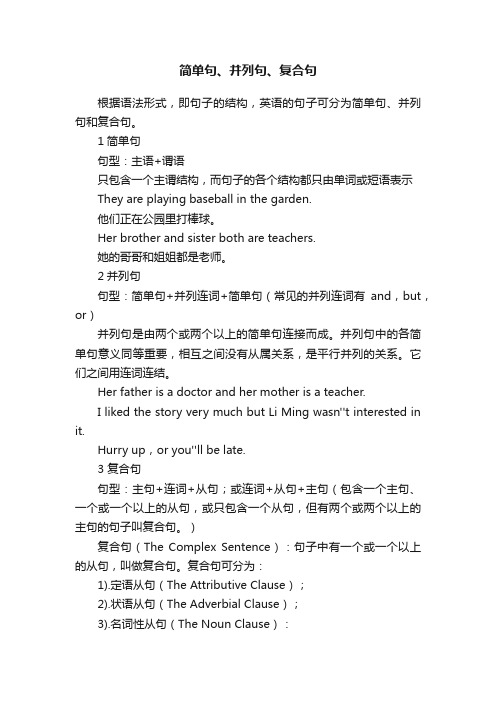
简单句、并列句、复合句根据语法形式,即句子的结构,英语的句子可分为简单句、并列句和复合句。
1简单句句型:主语+谓语只包含一个主谓结构,而句子的各个结构都只由单词或短语表示They are playing baseball in the garden.他们正在公园里打棒球。
Her brother and sister both are teachers.她的哥哥和姐姐都是老师。
2并列句句型:简单句+并列连词+简单句(常见的并列连词有and,but,or)并列句是由两个或两个以上的简单句连接而成。
并列句中的各简单句意义同等重要,相互之间没有从属关系,是平行并列的关系。
它们之间用连词连结。
Her father is a doctor and her mother is a teacher.I liked the story very much but Li Ming wasn''t interested in it.Hurry up,or you''ll be late.3 复合句句型:主句+连词+从句;或连词+从句+主句(包含一个主句、一个或一个以上的从句,或只包含一个从句,但有两个或两个以上的主句的句子叫复合句。
)复合句(The Complex Sentence):句子中有一个或一个以上的从句,叫做复合句。
复合句可分为:1).定语从句(The Attributive Clause);2).状语从句(The Adverbial Clause);3).名词性从句(The Noun Clause):一、定语从句定语从句的定义定语从句在句子中作定语,用来修饰一个名词、名词词组或者代词。
先行词和引导词被修饰的名词、名词词组或代词叫做先行词;在先行词和定语从句之间起连接作用的词叫做引导词。
引导词分为“关系代词”和“关系副词”。
关系代词和关系副词关系代词有:who, whom, whose, that, which, as。
简单句,并列句和复合句
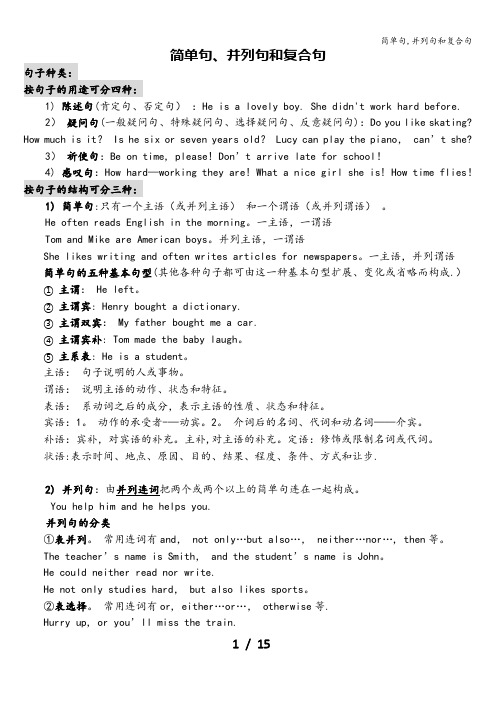
简单句,并列句和复合句简单句、并列句和复合句句子种类:按句子的用途可分四种:1) 陈述句(肯定句、否定句):He is a lovely boy. She didn't work hard before.2)疑问句(一般疑问句、特殊疑问句、选择疑问句、反意疑问句):Do you like skating? How much is it? Is he six or seven years old? Lucy can play the piano,can’t she?3)祈使句:Be on time, please! Don’t arrive late for school!4) 感叹句:How hard—working they are! What a nice girl she is! How time flies!按句子的结构可分三种:1) 简单句:只有一个主语(或并列主语)和一个谓语(或并列谓语)。
He often reads English in the morning。
一主语,一谓语Tom and Mike are American boys。
并列主语,一谓语She likes writing and often writes articles for newspapers。
一主语,并列谓语简单句的五种基本句型(其他各种句子都可由这一种基本句型扩展、变化或省略而构成.)①主谓: He left。
②主谓宾: Henry bought a dictionary.③主谓双宾: My father bought me a car.④主谓宾补: Tom made the baby laugh。
⑤主系表: He is a student。
主语:句子说明的人或事物。
谓语:说明主语的动作、状态和特征。
表语:系动词之后的成分,表示主语的性质、状态和特征。
宾语:1。
动作的承受者-—动宾。
2。
介词后的名词、代词和动名词——介宾。
(完整版)简单句、并列句、复合句、并列复合句
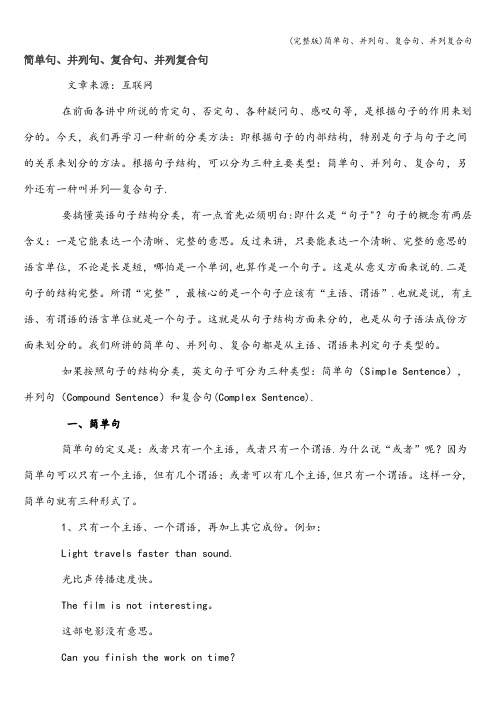
简单句、并列句、复合句、并列复合句文章来源:互联网在前面各讲中所说的肯定句、否定句、各种疑问句、感叹句等,是根据句子的作用来划分的。
今天,我们再学习一种新的分类方法:即根据句子的内部结构,特别是句子与句子之间的关系来划分的方法。
根据句子结构,可以分为三种主要类型:简单句、并列句、复合句,另外还有一种叫并列—复合句子.要搞懂英语句子结构分类,有一点首先必须明白:即什么是“句子"?句子的概念有两层含义:一是它能表达一个清晰、完整的意思。
反过来讲,只要能表达一个清晰、完整的意思的语言单位,不论是长是短,哪怕是一个单词,也算作是一个句子。
这是从意义方面来说的.二是句子的结构完整。
所谓“完整”,最核心的是一个句子应该有“主语、谓语”.也就是说,有主语、有谓语的语言单位就是一个句子。
这就是从句子结构方面来分的,也是从句子语法成份方面来划分的。
我们所讲的简单句、并列句、复合句都是从主语、谓语来判定句子类型的。
如果按照句子的结构分类,英文句子可分为三种类型:简单句(Simple Sentence),并列句(Compound Sentence)和复合句(Complex Sentence).一、简单句简单句的定义是:或者只有一个主语,或者只有一个谓语.为什么说“或者”呢?因为简单句可以只有一个主语,但有几个谓语;或者可以有几个主语,但只有一个谓语。
这样一分,简单句就有三种形式了。
1、只有一个主语、一个谓语,再加上其它成份。
例如:Light travels faster than sound.光比声传播速度快。
The film is not interesting。
这部电影没有意思。
Can you finish the work on time?你能按时完成工作吗?2、只有一个主语,但有几个谓语,再加上其它成份。
例如:The boy were running, shouting and laughing.男孩们一边跑,一边笑,一边喊叫着。
简单句、并列句和复合句(包括五大句型)

二、简单句、并列句和复合句(一)句子种类两种分类法1、按句子的用途可分四种:1)陈述句(肯定、否定):He is six years old; She didn't hear of you before.2)疑问句(一般、特殊、选择、反意):Do they like skating? How old is he? Is he six or seven years old? Mary can swim, can't she?3)祈使句:Be careful, boys; Don't talk in class4)感叹句:How clever the boy is!2、按句子的结构可分三种:1)简单句:只有一个主语(或并列主语)和一个谓语(或并列谓语)。
e.g. He often reads English in the morning.Tom and Mike are American boys.She likes drawing and often draws pictures for the wall newspapers.2) 并列句:由并列连词(and, but, or等)或分号(;)把两个或两个以上的简单句连在一起构成。
e.g. You help him and he helps you.The future is bright; the road is tortuous. 前途是光明的,道路是曲折的。
3)复合句:含有一个或一个以上从句的句子。
复合句包含:名词性从句(主语从句、宾语从句、表语从句和同位语从句)、定语从句和状语从句等。
e.g. The foreign visitors took a lot of pictures when they were at the Great Wall.(二)简单句的五种基本句型1、主语+系动词+表语:e.g. He is a student.2、主语+不及物动词:e.g. We work.3、主语+及物动词+宾语:e.g. Henry bought a dictionary.4、主语+及物动词+双宾语(间接宾语+直接宾语):e.g. My father bought me a car.5、主语+及物动词+复合宾语(宾语+宾补):e.g. Tom made the baby laugh.注:其他各种句子都可由这一种基本句型扩展、变更或省略而构成。
英语简单句并列句复合句

名师手记之: 英语篇(简单句、并列句和复合句)1.简单句、并列句和复合句① 句子种类两种分类法按照句子的用途, 英语的句子可分: 陈述句(肯定、否定)、疑问句(一般、特殊、选择、反意)、祈使句、感叹句等四种。
按照句子的结构可分: 简单句并列句和复合句三种。
简单句只有一个主语或并列主语和一个谓语或并列谓语。
并列句由并列连词and, but, or, so等)或分号(;)把两个或两个以上的简单句连在一起构成。
复合句:含有一个或一个以上从句的句子。
复合句包含:状语从句\名词性从句(主语从句、宾语从句、表语从句和同位语从句)和定语从句等三种。
② 并列句的分类并列句指把两个同等重要的句子连接在一起, 句子之间常用and, not only…but also…, neither…nor…, then等并列连词连接。
表示选择关系常用的连词有: or, either…or…, otherwise等表示转折关系常用的连词有: but, still, however, yet, while, when 等。
表示因果关系常用的连词有: so, for, therefore等。
2.状语从句:(1)状语从句的分类状语从句通常修饰主句的动词或整个句子, 由从属连词引导, 从属连词在从句中不充当句子成分。
根据状语从句所表达的不同意义和功能, 可分为时间、地点、原因、条件、目的、结果、让步、比较、方式等状语从句。
(2)连接状语从句的词语时间状语从句: when, whenever每当……, after, before, as, as soon as, hardly/ scarcely...when..., no sooner...than.。
.一……就……, while, till, until, since, once。
名词词组the first time第一次, last time最后一次, every/each time每次, the next time下次, the next day第二天, the moment, the minute, the second, the instant 一……就……;副词immediately, instantly, directly等也可作连词使用。
简单句、并列句、复合句
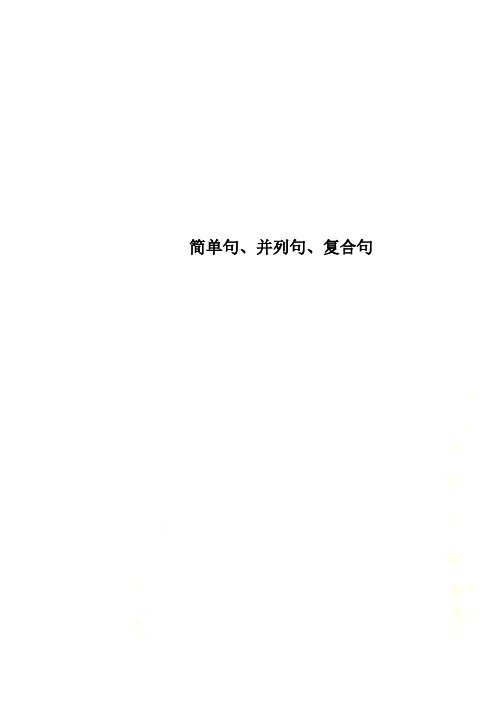
简单句、并列句、复合句简单句、并列句、复合句【知识点睛】一、句子分类____________(____________________________)____________________________________________(_____________________)⎧⎧⎪⎪⎪⎪⎨⎪⎪⎪⎪⎩⎨⎪⎧⎪⎪⎪⎨⎪⎪⎩⎩ 、、、 按分 句子按分 、、 二、陈述句、疑问句、祈使句、感叹句陈述句:用于说明事实或说话人的看法疑问句:用于提问祈使句:用于表示请求、命令、劝告、建议等感叹句:用于表达强烈的感情(一)陈述句有肯定和否定两种形式,多以句号结尾,读降调。
陈述句的否定式:1.be的否定式(be作系动词和助动词)2.助动词、情态动词的否定式3.除not外,其他否定词也可以构成否定句1)用no表示,no = not any/a2)never从不,决不,永不 seldom很少 hardly几乎不3)little, few几乎没有4)no one/nobody没有人5)nothing什么也没有6)neither of…没有什么(两者都不);none of…没有任何,什么都没有(三者或三者以上都不)7)too…to…太……以至于不能……(二)疑问句1. 一般疑问句(1)用什么词提问,用什么词回答。
—Are you a student? 你是一个学生吗?—Yes, I am. 是的,我是。
/—No, I’m not. 不,我不是。
(2)否定的一般疑问句往往表示惊讶、赞叹、怀疑等语气。
(注意yes/no的翻译)—Don’t you watch TV at night? 你晚上不看电视吗?—Yes, I do. 不,我看电视。
/—No, Idon’t. 是的,我不看电视。
(3)用其他词语代替yes/no,使语气更客气、委婉。
—Can you go to the movies with me?你能和我一起去看电影吗?—I’m afraid not. I have much homework to do. 恐怕不行,我有很多作业要做。
- 1、下载文档前请自行甄别文档内容的完整性,平台不提供额外的编辑、内容补充、找答案等附加服务。
- 2、"仅部分预览"的文档,不可在线预览部分如存在完整性等问题,可反馈申请退款(可完整预览的文档不适用该条件!)。
- 3、如文档侵犯您的权益,请联系客服反馈,我们会尽快为您处理(人工客服工作时间:9:00-18:30)。
• (2)主系表结构(S + V + P ) 在此句式中,V是系动词(link v.),常见的系动词有:look,seem,appear,sound,feel, taste,smell,grow,get,fall ill/asleep,stand/sit still, become,turn等。
• He is older than he looks.他比看上去要老。
含:名词性从句(主语从句、宾语从句、表语从句和同位 语从句)、定语从句和状语从句等。
• e.g. The foreign visitors took a lot of pictures when they were at the Great Wall
• 二、简单句 • 1、概述 • 只有一个主语和一个谓语动词的句子称为简
• 说明:S=主语;V=谓语;P=表语;O=宾语;IO=间 接宾语;DO=直接宾语;C=宾语补足语
• (1)主谓结构(S + V 在此句式中,V是不及物动 词,又叫自动词(vi.)。
• He runs quickly.他跑得快。
• They listened carefully.他们听得很仔细。 He suffered from cold and hunger.
• 按句子的结构可分三种:
• 1)简单句:只有一个主语(或并列主语)和一个谓语 (或并列谓语).
• e.g. He often reads English in the morning.
• Tom and Mike are American boys.
• She likes drawing and often draws pictures for the w all newspapers.
• He seems interested in the book. • 他似乎对这本书感兴趣。 • The story sounds interesting. • 这个故事听起来有趣。 • The desk feels hard.书桌摸起来很硬。 • The cake tastes nice.饼尝起来很香。 • The flowers smell sweet and nice.花闻起来香甜。 • You have grown taller than before. • 你长得比以前高了。 • He has suddenly fallen ill.他突然病倒了。 • He stood quite still.他静静地站着。 • He becomes a teacher when he grew up. • 他长大后当了教师。
单句。
• I am a student. • 我是一个学生。
• She likes English very much. • 她非常喜欢英语。
• He usually does morning exercises on the playground.
•句的五种基本句型 • 1、主语+系动词+表语:e.g. He is a student. • 2、主语+不及物动词:e.g. We work. • 3、主语+及物动词+宾语:
简单句、并列句和复合句
• (一)句子种类两种分类法
• 按句子的用途可分四种:
• 1)陈述句(肯定、否定) • He is six years old; She didn’t hear of you before. • 2)疑问句(一般、特殊、选择、反意) • Do they like skating? How old is he? Is he six or • seven years old? Mary can swim, can’t she? • 3)祈使句: • Be careful, boys; Don’t talk in class • 4)感叹句: • How clever the boy is!
e.g. Henry bought a dictionary.
• 4、主语+及物动词+双宾语(间接宾语+直接宾 语):e.g. My father bought me a car.
• 5、主语+及物动词+复合宾语(宾语+宾补): e.g. Tom made the baby laugh.
• 注:其他各种句子都可由这一种基本句型扩展、 变化或省略而构成
• 他们在家乡种水稻。
• He’s got a chair to sit on.他有椅子坐。 Please turn the sentence into English.
• 请把这个句于译成英语。
• (3)主谓宾结构(S + V + O ) 在此句式中,V 是及物动词(vt.),因此有宾语。
• I saw a film yesterday.我昨天看了一部电影。 • Have you read the story?你读过这个故事吗? • They found their home easily. • 他们很容易地找到他们的家。 • They built a house last year. • 他们去年建了一所房子。 • They’ve put up a factory in the village. • 他们在村里建了一座工厂。 • They have taken good care of the children. • 他们把这些孩子照看得很好。 • You should look after your children well. • 你应该好好照看你的孩子。
• 注意:有些动词同时也是及物动词,可构成 SVO句式。
• He looked me up and down.他上下打量我。 He reached his hand to feel the elephant.
• 他伸出手来摸象。
• They are tasting the fish.他们在品尝鱼。 They grow rice in their hometown.
• 他挨冻受饿。
• China belongs to the third world country.
• 中国属于第三世界国家。
The gas has given out.煤气用完了。
• My ink has run out.我的钢笔水用完了。 Plants grow well all the year round.一年四季植物生 长良好。
• 2) 并列句:由并列连词(and, but, or等)或分号(;)把 两个或两个以上的简单句连在一起构成。
• e.g. You help him and he helps you.
• The future is bright; the road is tortuous. • 前途是光明的,道路是曲折的。 • 3)复合句:含有一个或一个以上从句的句子。复合句包
